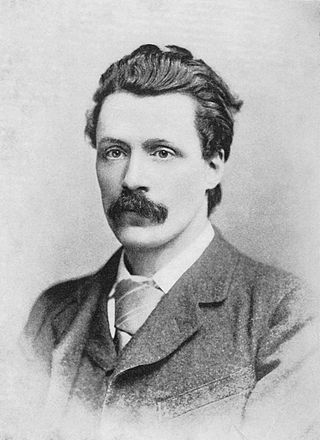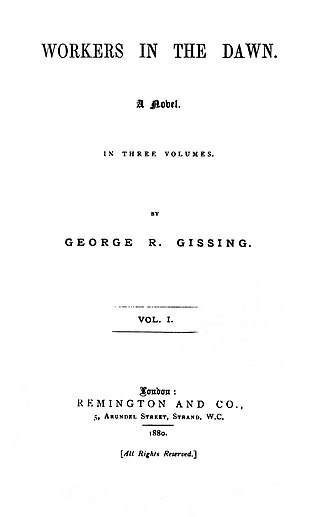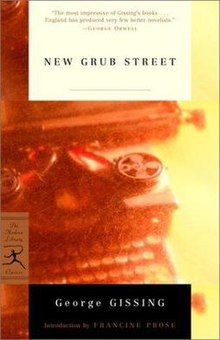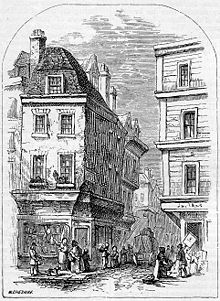
Little Women is a coming-of-age novel written by American novelist Louisa May Alcott, originally published in two volumes in 1868 and 1869. The story follows the lives of the four March sisters—Meg, Jo, Beth, and Amy—and details their passage from childhood to womanhood. Loosely based on the lives of the author and her three sisters, it is classified as an autobiographical or semi-autobiographical novel.

George Meredith was an English novelist and poet of the Victorian era. At first, his focus was poetry, influenced by John Keats among others, but Meredith gradually established a reputation as a novelist. The Ordeal of Richard Feverel (1859) briefly scandalised Victorian literary circles. Of his later novels, the most enduring is The Egoist (1879), though in his lifetime his greatest success was Diana of the Crossways (1885). His novels were innovative in their attention to characters' psychology, and also portrayed social change. His style, in both poetry and prose, was noted for its syntactic complexity; Oscar Wilde likened it to "chaos illumined by brilliant flashes of lightning". Meredith was an encourager of other novelists, as well as an influence on them; among those to benefit were Robert Louis Stevenson and George Gissing. Meredith was nominated for the Nobel Prize in Literature seven times.

George Robert Gissing was an English novelist, who published 23 novels between 1880 and 1903. Meagrely successful in his lifetime, he had by the 1940s been recognised as a literary genius, with George Orwell pronouncing that "England has produced few better novelists". Gissing's best-known works have reappeared in modern editions. They include The Nether World (1889), New Grub Street (1891) and The Odd Women (1893). He retains a small but devoted group of followers.

The Mystery of Edwin Drood is the final novel by the English author Charles Dickens, originally published in 1870.

Walter Ernest Allen was an English literary critic and novelist and one of the Birmingham Group of authors. He is best known for his classic study The English Novel: a Short Critical History (1951).

The Slough of Despond is a fictional, deep bog in John Bunyan's allegory The Pilgrim's Progress, into which the protagonist Christian sinks under the weight of his sins and his sense of guilt for them.

Sarah Grand was an English feminist writer active from 1873 to 1922. Her work revolved around the New Woman ideal.
Ed Reardon's Week is a sitcom on BBC Radio 4 recorded semi-naturalistically in the style of a radio drama. It concerns the story of a curmudgeonly middle-aged writer described in the show's publicity material as an "author, pipesmoker, consummate fare-dodger and master of the abusive email". The names of two central characters, Ed Reardon and Jaz Milvane, are references to the characters Edwin Reardon and Jasper Milvain, who appear in George Gissing's 1891 novel New Grub Street, which is set in the hack-literary London of the late 19th century, although Edward was revealed to be his given name in the second episode of the third series and Milvain is referred to as Jaz Milvane.

The Clayhanger Family is a series of novels by Arnold Bennett, published between 1910 and 1918. Though the series is commonly referred to as a "trilogy", and the first three novels were published in a single volume, as The Clayhanger Family, in 1925, there are actually four books. All four are set in the "Five Towns", Bennett's thinly disguised version of the six towns of the Staffordshire Potteries.

Austin Frederic Harrison (1873–1928) was a British journalist and editor, best known for his editorship of The English Review from 1909 until 1923.

Alfred Charles William Harmsworth, 1st Viscount Northcliffe, was a British newspaper and publishing magnate. As owner of the Daily Mail and the Daily Mirror, he was an early developer of popular journalism, and he exercised vast influence over British popular opinion during the Edwardian era. Lord Beaverbrook said he was "the greatest figure who ever strode down Fleet Street." About the beginning of the 20th century there were increasing attempts to develop popular journalism intended for the working class and tending to emphasize sensational topics. Harmsworth was the main innovator. He said, "News is something someone wants to suppress. Everything else is advertising."

The Nether World (1889) is a novel written by the English author George Gissing. The plot concerns several poor families living in the slums of 19th-century London. Rich in naturalistic detail, the novel concentrates on the individual problems and hardships which result from the typical shortages experienced by the lower classes—want of money, employment and decent living conditions. The Nether World is pessimistic and concerns exclusively the lives of poor people: there is no juxtaposition with the world of the rich.
Christopher Douglas is a British actor and writer. He is the voice of Ed Reardon in BBC Radio 4's long-running sitcom Ed Reardon's Week, which he co-writes with Andrew Nickolds. Ed Reardon's Week has completed fourteen series and was the winner of the Broadcasting Press Guild's "Best Radio Programme" award in 2005 and again in 2010. Douglas is also the voice and co-creator of the world's most disappointing cricketer Dave Podmore, a Radio 4 regular since 2001.
Eve's Ransom is a novel by George Gissing, first published in 1895 as a serialisation in the Illustrated London News. It features the story of a mechanical draughtsman named Maurice Hilliard, who comes into some money, which enables him to live without working. As part of his resulting travels, he meets and falls in love with Eve Madeley, a book keeper.

Workers in the Dawn is a novel by George Gissing, which was originally published in three volumes in 1880. It was the first of Gissing's published novels, although he had been working on another prior to this. The work focuses on the unhappy marriage of Arthur Golding, a rising artist from a poor background, and Carrie Mitchell, a prostitute. This plot was partly based on Gissing's negative experiences of marriage to his first wife. It also was designed to serve the function of political polemic, highlighting social issues that Gissing felt strongly about. Reviews of the novel generally recognised some potential in the author, but were critical of Workers in the Dawn. After reading the first known published review in the Athenaeum, Gissing was driven to describe critics as "unprincipled vagabonds".

Gone Girl is a 2012 crime thriller novel by American writer Gillian Flynn. It was published by Crown Publishing Group in June 2012. The novel was popular and made the New York Times Best Seller list. The sense of suspense in the novel comes from whether Nick Dunne is responsible for the disappearance of his wife Amy.

Lady of the Forest: A Novel of Sherwood is a 1992 historical fiction novel by American author Jennifer Roberson. A re-telling of the Robin Hood legend from the perspective of twelve characters associated with the legend, the story centers around English noblewoman Lady Marian FitzWalter's encounters with Lord Robert of Locksley and his scheming rival the Sheriff of Nottingham amid the backdrop of Prince John's schemes – he aims to increase his own wealth and power at the expense of post-Conquest England and his brother, King Richard.
The Gissing family of Great Britain included several noted writers, Olympic competitors, and teachers.
Marie Connor Leighton was a prolific author of serial fiction and melodramatic novels. She married fellow writer Robert Leighton and her most famous work Convict 99 was written jointly with him. However her writing income was far in excess of his.














